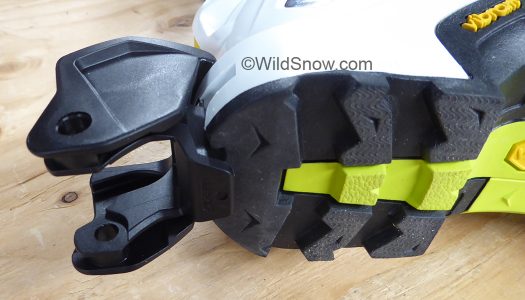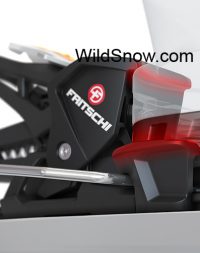Sombreros off to Fritschi. When they entered the tech binding world with Vipec in 2013, the crew from Reichenbach, Switzerland did tell me “this is only the beginning.” I believed them, at least to the extent that you believe PR before you hold the evidence in your hot little hands. Which means I’ll admit to some skepticism mixed in with my optimism.
As Vipec went through iterations; defect improvements and overall positive changes, I became a believer in Fritschi because I saw their commitment. Only one thing held back my unquestioning fundamentalist faith in the Swiss way of product development: Vipec continued to to use a heel unit with no more vertical elastic travel than any other “classic” tech binding. The problem was obvious. Thus, I suspected those who toiled at the feet of the Jungfrau were cobbling a solution. I was right.
Enter Tecton
First, know that Fritschi will sell TWO very different tech compatible bindings during 2017-2018. First, they improved the Vipec toe (more on that below) to create the Vipec Evo 12. They then paired the new Evo toe with an alpine-like heel to create the Tecton. (Even the name is better, Vipec always begged questions, “Tecton” says exactly what it is, a tech version of power laden Ultron, and thus the adversary of all other tech binding companies!).
We’re excited. At 550 grams (Fritschi Tecton 12, per pair without brakes), Tecton is about 100 grams lighter than the other brand with similar configuration, and only 50 grams heavier than the new Vipec Evo. In terms of aesthetics Tecton looks sweet, and it performs on the bench exactly as I’d expect from this sort of configuration; a heel with alpine-like vertical travel. (Real testing must of course commence, bear in mind this is a first-look for a product that won’t retail until fall of 2017.)
So why stick with the Vipec instead of upgrading Tecton? Me, I can’t think of any good reason (though weight is always an issue even in small doses). Perhaps those of you who like the easy on-the-fly mode changes provided by the Vipec heel may want to stick with the tried and true (though Tecton does provide numerous ways to work with its heel, especially if you’re agile enough to simply reach down and yank on the heel unit cocking lever, see video below). Otherwise, unless you’re partial to ultra simple and low mass classic tech bindings, perhaps you’ll be interested in the only tech binding that releases to the side at the toe — and provides an alpine-like ~8 mm of vertical elastic heel travel.
Here in the WildSnow production studio, I enjoyed an intimate hands-on session with both Tecton and Evo. Ultron seemed to be comfortable with me, but I did glance over my shoulder now and then to be sure he approved. Read on.

Tecton in touring mode, heel lift deployed. Heel-flat-on-ski mode is available. Mode change is done by a simple movement of the cocking lever, to configure position of components for uphill or downhill use.

Tecton heel ski flex compensation spring and length adjustment, same configuration as Vipec, works. Screw patterns for Tecton, Evo and prior Vipec are said to be all the same, though I’m 99% on this, not 100%.

‘Power Cup’ is a bit of tricky business that helps the heel perform like an alpine unit as well as preventing accidental lateral exit of the boot during aggressive downhill skiing. I believe this thing is forgiving in terms of boot sole wear, but one does wonder.

Secret sauce of the Power Cup are two vertical rails (red) that integrate with the standard heel tech fitting. A known problem with alpine heel “cups” is your heel can slide out to the side during aggressive skiing, or just move enough to introduce slop. Not so here. This is an ingenious use of the boot fitting.
The question will be asked: Can Tecton change modes on the fly between downhill and uphill configuration? The process doesn’t appear to be as ski pole easy as the Vipec, but it appears a process could be developed — probably most easily for switching from locked heel to touring mode.
Video below shows how the Tecton binding heel is configured by moving the cocking lever in various ways. Note the the boot step-in being assisted at the heel by the demonstrator, this is not necessary with a person stepping in at body weight. At the beginning I left in a couple of boot toe “practice” insertions showing how the boot interacts with what is now a large pedal that triggers toe wing closure. Again, this works much better when you’re actually stepping into the binding rather than fooling around on a workbench, so don’t take what you see as meaning the toe is difficult to get into. It’s quite the opposite and the best yet. I carpet tested extensively. Now easily on par with other tech bindings.
Note, all Fritschi tech binding screw patterns are said to be the same, especially for the the toe. Easy upgrades. Heel screws might vary a bit depending on if you’re using a longer demo plate or the shorter consumer-retail version of the heel plate.
Now, what about the upgraded Vipec, Evo 12? Heel remains the same. Evo toe has a much better step-in function using a large beefy pedal under the toe of the boot, combined with an indexing wall you push your toe against as you step down. In carpet tests this system worked well, SNAP! But like all tech binding toe indexing systems this will be sensitive to boot wear and icing.

Evo and Tecton toes are improved versions of Vipec. No more swapping of spacers for different boots.

It amuses me that the Swiss would provide binding color customization, I’d have thought this would be the Italians, or French. Yes, I’m such a stereotyper.
In my view, the major Vipec change here is the Evo (Tecton) toe is NOT configured for boot toe shape size by swapping spacer clips on the toe lever. Instead, the binding works with nearly all touring boots, exceptions being obviously non-standard shoes such as Dynafit TLT-7. I should mention that part of the Fritschi forward (upward at the heel) system is the binding being shaped so the boot toe bumps against it and opens the toe wings — thus letting you out. Evo has a new configuration for this that appeared to work well, but this is a function that should always be bench tested before taking an Evo or Tecton into the wild. (The binding toe wing width adjustment is still present — Fritschi claims it is rarely needed.)
Available Brakes (Easily swapped or eliminated.)
Ski Crampons
Remain the same for both bindings, one of our favorite crampon systems, very easy to take on and off.
Weights
At a claimed 550 grams (per pair, no brakes) Tecton is 50 grams heavier than Vipec Evo. Weight of Tecton compares favorably to other brand ski touring bindings of this type. Interestingly, the new 500 gram Vipec weight is significantly lighter than this season’s ‘Black’ Vipec at 612 grams verified. I’m assuming that’s because they used more reinforced plastic.
History
Now that Vipec has been around a while, I asked Fritschi how long the various development processes have taken. They told me they engaged the process of making a tech binding beginning 7 years ago. I’m told the Tecton is considered the culmination of the Vipec project, and the concept of an alpine-like heel has been part of the project from the beginning — as Fritschi was already familar with such heels due to their Freeride and other frame bindings.

Fritschi bindings are now called ‘Fritschi” instead of Diamir, and a new logo. This photo shows how the boot heel rests directly on a solid heel pad, per the configuration of alpine bindings, for a solid skier-ski connection.
Trivia
You’ll notice the “Diamir” moniker has gone away. “Too confusing.” Note the new Fritschi logo, providing that Swiss red along with a white cross.
Conclusions
Both Tecton and Evo appear mature in design and engineering, but the beta and consumer test cycles need to commence for the ultimate take. It’s not exactly child’s play to create this sort of ski binding. One example out of many: The tech binding type boot-binding interface can be sensitive to axial (forward back) pressure created by the ski flexing. Virtually all tech bindings have some way of compensating for this (Vipec & Tecton both do), but how well do they do? More, durability is always a question until a binding is thoroughly vetted.
Should you skip your planned purchase of Vipec Black for Vipec Evo (the bindings with classic style tech heel)? I’d say no. The Black version Vipec is excellent. But if you’re not in a hurry, Evo appears to be even better. And you freeriders out there who like Fritschi will clearly want to wait for the Tecton
In my view, “safety” is the over arching issue here. Fritschi constantly harps on their binding being “safe.” What’s that mean?
Me, I take ski binding safety to mean you’ve got a machine that you won’t ski out of accidentally, when set on fairly normal tension settings. In other words, RETENTION is job one. After that, you worry about protecting your legs from fractures and soft tissue damage.
Prior to Tecton, only a couple of other brand tech or hybrid-tech bindings provided enough vertical heel travel to do a thorough job of retention at normal tension values. Both of the Fritschi competitors who provide advanced tech heels still attempt to couple side release with the heel mechanisms. That can be a challenge for numerous reasons, perhaps the most important being that the forces you apply to a ski in a turn can match the forces that trigger a lateral binding release, thus opening the heel to the side — and you go flying. Fritschi by virtue of their side-release toe unit manages to de-couple lateral release from the binding heel and still provide a frameless tech binding. Perhaps the holy grail? We shall see.
Check our Fritschi Diamir Vipec articles and news.
WildSnow.com publisher emeritus and founder Lou (Louis Dawson) has a 50+ years career in climbing, backcountry skiing and ski mountaineering. He was the first person in history to ski down all 54 Colorado 14,000-foot peaks, has authored numerous books about about backcountry skiing, and has skied from the summit of Denali in Alaska, North America’s highest mountain.



